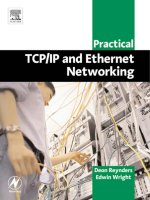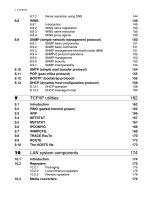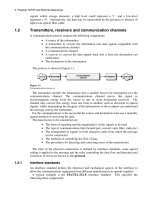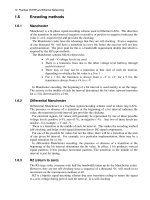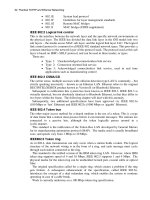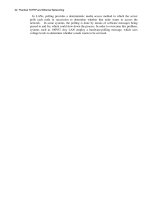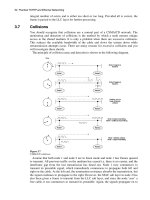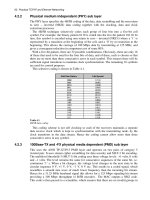Practical TCP/IP and Ethernet Networking- P17 pdf
Bạn đang xem bản rút gọn của tài liệu. Xem và tải ngay bản đầy đủ của tài liệu tại đây (220.24 KB, 5 trang )
62 Practical TCP/IP and Ethernet Networking
4.2.2 Physical medium independent (PHY) sub layer
The PHY layer specifies the 4B/5B coding of the data, data scrambling and the non return
to zero – inverted (NRZI) data coding together with the clocking, data and clock
extraction processes.
The 4B/5B technique selectively codes each group of four bits into a five-bit cell
symbol. For example, the binary pattern 0110 is coded into the five-bit pattern 01110. In
turn, this symbol is encoded using non return to zero – inverted (NRZ-I) where a ‘1’ is
represented by a transition at the beginning of the cell, and a ‘0’ by no transition at the
beginning. This allows the carriage of 100 Mbps data by transmitting at 125 MHz, and
gives a consequent reduction in component cost of some 80%.
With a five-bit pattern, there are 32 possible combinations. Obviously, there are only 16
of these that need to be used for the four bits of data, and of these, each is chosen so that
there are no more than three consecutive zeros in each symbol. This ensures there will be
sufficient signal transitions to maintain clock synchronization. The remaining 16 symbols
are used for control purposes.
This selective coding is shown in Table 4.1.
Table 4.1
4B/5B data coding
This coding scheme is not self clocking so each of the receivers maintains a separate
data receive clock which is kept in synchronization with the transmitting node, by the
clock transitions in the data stream. Hence the coding cannot allow more than three
consecutive zeros in any symbol.
4.2.3 100Base-TX and -FX physical media dependent (PMD) sub layer
This uses the ANSI TP-X3T9.5 PMD layer and operates on two pairs of category 5
twisted pair. It uses stream cipher scrambling for data security and MLT-3 bit encoding.
The multilevel threshold-3 (MLT-3) bit coding uses three voltage levels: +1 volts, 0 volts
and –1 volts. The level remains the same for consecutive sequences of the same bit, i.e.
continuous ‘1’ s. When a bit changes, the voltage level changes to the next state in the
circular sequence 0 V, +1 V, 0 V, –1 V, 0 V etc. This results in a coded signal, which
resembles a smooth sine wave of much lower frequency than the incoming bit stream.
Hence for a 31.25 MHz baseband signal this allows for a 125 Mbps signaling bit stream
providing a 100 Mbps throughput (4 B/5B encoder). The MAC outputs a NRZ code.
This code is then passed to a scrambler, which ensures that there are no invalid groups in
Fast and gigabit Ethernet systems 63
its NRZI output. The NRZI converted data is passed to the three level code block and the
output is then sent to the transceiver. The code words are selectively chosen so the mean
line signal line zero, in other words the line is DC balanced.
The three level code results in a lower frequency signal. Noise tolerance is not as high
as 10Base-T because of the multilevel coding system; hence data grade (category 5) cable
is required.
Two pair wire, RJ45 connectors and a hub are requirements for 100Base-TX. These
factors and a maximum distance of 100 m between the nodes and hubs make for a very
similar architecture to 10Base-T.
4.2.4 100Base-T4 physical media dependent (PMD) sub layer
The 100Base-T4 systems use four pairs of Category 3 UTP. It uses data encoded in an
eight binary six ternary (8B/6T) coding scheme similar to the MLT-3 code. The data is
encoded using three voltage levels per bit time of +V, 0 volts and –V, these are usually
written as simply +, 0 and –. This coding scheme allows the eight bits of binary data to be
coded into six ternary symbols, and reduces the required bandwidth to 25 MHz. The 256
code words are chosen so the line has a mean line signal of zero. This helps the receiver
to discriminate the positive and negative signals relative to the average zero level. The
coding utilizes only those code words, which have a combined weight of 0 or +1, as well
as at least two signal transitions for maintaining clock synchronization. For example, the
code word for the data byte 20H is –++–00, which has a combined weight of 0 while
40H is –00+0+, which has a combined weight of +1.
If a continuous string of code words of weight +1 is sent then the mean signal will
move away from zero, known as DC wander. This causes the receiver to misinterpret the
data since it is assuming the average voltage it is seeing, which is now tending to ‘+1’, is
its zero reference. To avoid this situation, a string of code words of weight +1 is always
sent by inverting alternate code words before transmission. Consider a string of
consecutive data bytes 40H, the codeword is –00+0+ which has weight +1. This is sent
as the sequence –00+0+, +00–0–, –00+0+, +00–0– etc, which results in a mean signal
level of zero. The receiver consequently reinverts every alternate codeword prior to
decoding.
These signals are transmitted in half-duplex over three parallel pairs of category 3, 4 or
5 UTP cable, while a fourth pair is used for reception of collision detection signals. This
is shown in Figure 4.3.
Figure 4.3
100Base-T4 wiring
64 Practical TCP/IP and Ethernet Networking
100Base-TX and 100Base-T4 are designed to be interoperable at the transceivers using
a media independent interface and compatible (class 1) repeaters at the hub. Maximum
node to hub distances of 100 m and 250 m maximum network diameter are supported.
Maximum hub-to-hub distance of 10 m.
4.2.5 100Base-T2
The 100Base-T2 system was published by the IEEE in 1996 as the IEEE 802.3y standard
but has not been marketed at this stage. It was designed to address the shortcomings of
100Base-T4, making full-duplex 100 Mbps accessible to installations with only two
category 3 cable pairs available. The standard was completed two years after 100Base-
TX, at which stage the -TX had such market dominance that the -T2 products were not
commercially produced. However it is mentioned here for reference and because its
underlying technology using digital signal processing (DSP) techniques and five-level
coding (PAM-5) is used for the 1000Base-T systems on two category 5 pairs. These are
discussed in detail under 1000Base-T systems in Section 4.5.
The features of 100Base-T2 are:
• Uses two pairs of category 3, 4 or 5 UTP
• Uses both pairs for simultaneously transmitting and receiving – commonly
known as dual-duplex transmission. This is achieved by using digital signal
processing (DSP) techniques
• Uses a five-level coding scheme with five phase angles called pulse
amplitude modulation (PAM 5) to transmit two bits per symbol
4.2.6 100Base-T hubs
The IEEE 802.3u specification defines two classes of 100Base-T hubs, which are
normally called repeaters:
• Class I, or translational repeaters which can support both TX/FX and T4
systems
• Class II, or transparent repeaters which support only one signaling system
The class I repeaters have greater delays (0.7 µs maximum) in supporting both
signaling standards and so only permit one hub in each collision domain. The class I
repeater fully decodes each incoming TX or T4 packet into its digital form at the media
independent interface (MII) and then sends the packet out as an analog signal from each
of the other ports in the hub. Repeaters are available with all T4 ports, all TX ports or
combinations of TX and T4 ports, called translational repeaters. Their layout is shown in
Figure 4.4.
The class II repeaters operate like a 10Base-T repeater connecting the ports (all of the
same type) at the analog level. These then have lower inter-repeater delays (0.46 µs
maximum) and so two repeaters are permitted in the same collision domain, but only 5 m
apart. Alternatively, in an all fiber network, the total length of all the fiber segments is
228 meters. This allows two 100 m segments to the nodes with 28 m between the
repeaters or any other combination. Most fast Ethernet repeaters available today are class
II.
Fast and gigabit Ethernet systems 65
Figure 4.4
Class I and class II fast Ethernet repeaters
4.2.7 100Base-T adapters
Adapter cards are readily available as standard 100Mbps and as 10/100Mbps. These latter
cards are interoperable at the hub on both speed systems.
4.3 Fast Ethernet design considerations
4.3.1 UTP cabling distances 100Base-TX/T4
Maximum distance between UTP hub and desktop NIC is 100 meters, made up
as follows:
• 5 meters from hub to patch panel
• 90 meters horizontal cabling from patch panel to office punch-down block
• 5 meters from punch-down block to desktop NIC
4.3.2 Fiber optic cable distances 100Base-FX
The following maximum cable distances are in accordance with the 100Base-T bit budget
(see Section 4.4.3).
Node to hub: maximum distance of multimode cable (62.5/125) is 160 meters (for
connections using a single Class II repeater).
Node to switch: maximum multimode cable distance is 210 meters.
Switch-to-switch: maximum distance of multimode cable for a backbone connection
between two 100Base-FX switch ports is 412 meters.
Switch-to-switch, full-duplex: maximum distance of multimode cable for a full-duplex
connection between two 100Base-FX switch ports is 2000 meters.
Note The IEEE have not included the use of single mode fiber in the 802.3u standard.
However numerous vendors have products available enabling switch-to-switch distances
of up to ten to twenty kilometers using single mode fiber.
4.3.3 100Base-T repeater rules
The cable distance and the number of repeaters, which can be used in a 100Base-T
collision domain, depends on the delay in the cable and the time delay in the repeaters
and NIC delays. The maximum round-trip delay for 100Base-T systems is the time to
66 Practical TCP/IP and Ethernet Networking
transmit 64 bytes or 512 bits and equals 5.12 µs. A frame has to go from the transmitter to
the most remote node then back to the transmitter for collision detection within this round
trip time. Therefore the one-way time delay will be half this.
The maximum sized collision domain can then be determined by the following
calculation:
Repeater delays + Cable delays + NIC delays + Safety factor (5 bits
minimum)< 2.56 µs
The following Table 4.2 gives typical maximum one-way delays for various
components. Repeater and NIC delays for specific components can be obtained from the
manufacturer.
Table 4.2
Maximum one-way fast Ethernet component delays
Notes
If the desired distance is too great it is possible to create a new collision domain by using
a switch instead of a repeater.
Most 100Base-T repeaters are stackable, which means multiple units can be placed on
top of one another and connected together by means of a fast backplane bus. Such
connections do not count as a repeater hop and make the ensemble function as a
single repeater.
4.3.4 Sample calculation
Can two fast Ethernet nodes be connected together using two class II repeaters connected
by 50 m fiber? One node is connected to the first repeater with 50 m UTP while the other
has a 100 m fiber connection.
Calculation: Using the time delays in Table 4.3
Table 4.3
Time delays
